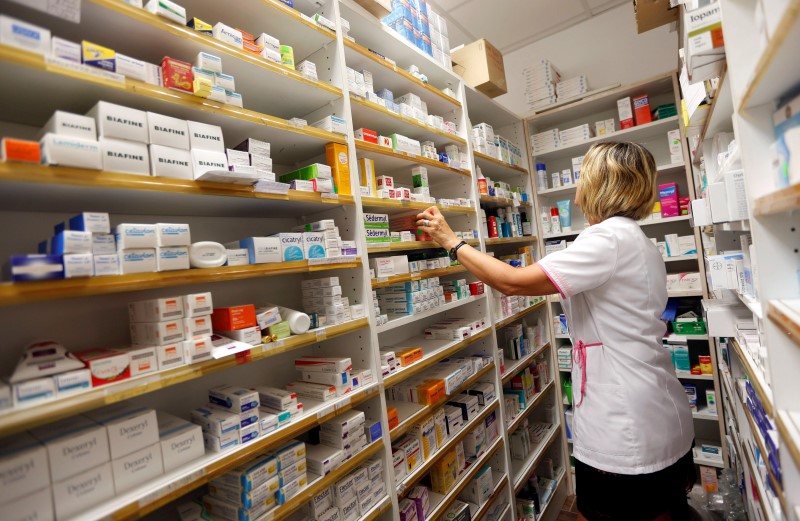By Ben Hirschler
LONDON (Reuters) - Global pressure on health spending is forcing the $1 trillion (£770.12 billion)-a-year pharmaceutical industry to look for new ways to price its products: charging based on how much they improve patients' health, rather than how many pills or vials are sold.
In the United States, both parties are promising fresh action on drug prices whoever wins the White House. In Europe, economies are stalled, squeezing state health budgets. And in China and other Asian markets, governments are getting tougher with suppliers.
Pricing drugs based on clinical outcomes is one way to ensure that limited funds bring the most benefits to patients now and pay for the most promising medical advances in future. Some experiments in pricing have already been made.
But shifting the overall industry to a new model requires improvements in data collection and a change in thinking, say drug pricing experts.
"Eventually, we are going to get there," said Kurt Kessler, managing principal at ZS Associates in Zurich, which advises companies on sales and marketing strategies. "But it is a long, tough slog because it's difficult to get the right data and agree on what the right outcomes are to measure."
In the past, governments and insurers made room in their budgets for new drugs by switching to cheap generics as patents expired on older drugs. But today generics already account for nearly nine out of every 10 prescriptions in key markets like the United States, and fewer big drugs are going off patent. That leaves little headroom for pricey new medicines for cancer and other hard-to-treat diseases, even as they come to market in growing numbers. The U.S. Food and Drug Administration has already approved 16 new drugs this year. Investors got a wake-up call on the issue last Friday when $10 billion was lopped off the market value of Novo Nordisk (CO:NOVOb) as the world's biggest diabetes firm warned of falling U.S. prices.
Pharmacy benefit managers administering U.S. health plans are pushing back hard by excluding some drugs deemed too expensive - including Novo’s - leading to a crunch in areas like diabetes, a disease that now accounts for 12 percent of global healthcare spending.
The Danish group has an unusually high exposure to the U.S. market, but it is not alone in signalling tough times ahead.
The chief executives of Novartis (S:NOVN), Eli Lilly (N:LLY) and GlaxoSmithKline (L:GSK) have all warned recently that pricing will become increasingly challenging across the board.
Accounting for 40 percent of global drug sales, the fate of the U.S. market is front and centre in the minds of drug company executives, some of whom privately admit to preparing for a "confrontational" period in relations with politicians.
Both Hillary Clinton and Donald Trump have suggested new measures to curb prices, including allowing imports from lower-cost countries, while individual U.S. states, starting with Vermont, are working on transparency legislation that would require firms to disclose costs to justify drug prices.
Novartis CEO Joe Jimenez believes drugmakers must develop value-for-money pricing models, like the performance-based deal the Swiss drugmaker recently struck with two U.S. insurers for its new heart failure drug.
Under that deal, payments for Novartis' Entresto pill are to be calculated in future based on the proven reduction in the proportion of the insurers' patients admitted to hospital for heart failure, not on the number of pills they consume.
The aim is a flexible pricing system that rebates healthcare providers when a drug doesn’t work as planned and charges more when it works well.
EUROPE IN VANGUARD
Europe is in the vanguard of such moves. Britain agreed an early performance-based deal for a Johnson & Johnson (N:JNJ) blood cancer drug back in 2007 and Italy also uses patient data to pay for cancer drugs based on actual patient responses.
GSK CEO Andrew Witty sees this outcomes-based approach slowly becoming the norm in more disease areas and geographies.
"Whoever wins the election in the U.S., and also in Europe, we will see those conversations play out over the next few years," he told Reuters. "I am not particularly expecting anything dramatic in 2017. I would say it is worth keeping an eye open for evolution of change, probably in ’18 and ’19."
The pharmaceutical industry's European trade association is already discussing ways to shift to outcomes pricing, following price curbs in Germany that have caused some companies to pull products off the market, and effective rationing in Britain, where strict cost-effectiveness rules apply.
Authorities in Asia's two biggest markets, China and Japan, are also intervening in new ways to cap runaway costs.
Dani Saurymper, manager of the AXA Framlington Health fund, believes the issue is going to move up the agenda for investors, not least with the arrival of gene and cell therapies. These could cure diseases like haemophilia and certain cancers, but at a cost of hundreds of thousands or even $1 million a patient.
"Pay for performance is going to become much more relevant," he said. Still, the obstacles are formidable. Drug companies and healthcare providers will need to work together to develop systems that capture and prove a medicine's clinical value, ideally using computerised systems that are only just emerging.
There are also potential legal pitfalls, given the need to establish clear-cut clinical outcomes for patients and determine how much of an effect should be attributed to the medicine or other healthcare inputs.

"Overall, it is the right direction but there are many practical difficulties," said Helen Roberts, a specialist in healthcare at law firm BonelliErede. "There may well be legal challenges if there is disagreement as to whether an outcome has actually been achieved."